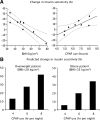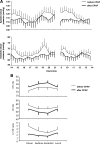Treatment of obstructive sleep apnea improves cardiometabolic function in young obese women with polycystic ovary syndrome
- PMID: 21123449
- PMCID: PMC3048326
- DOI: 10.1210/jc.2010-1187
Treatment of obstructive sleep apnea improves cardiometabolic function in young obese women with polycystic ovary syndrome
Abstract
Context: Women with polycystic ovary syndrome (PCOS) are insulin resistant and have a high risk of early-onset diabetes and cardiovascular disease. Obstructive sleep apnea (OSA) has adverse cardiometabolic consequences and is highly prevalent in women with PCOS. We sought to determine whether continuous positive airway pressure (CPAP) treatment of OSA has beneficial effects on cardiometabolic function in PCOS.
Methods: Laboratory polysomnography and cardiometabolic measurements including insulin sensitivity and secretion (iv glucose tolerance test); 24-h profiles of plasma catecholamines, cortisol, and leptin; and daytime profiles of blood pressure and cardiac autonomic activity (heart rate variability) were obtained at baseline and again after 8 wk of home CPAP treatment with daily usage monitoring.
Results: CPAP treatment modestly improved insulin sensitivity after controlling for body mass index (P = 0.013). The change in insulin sensitivity correlated positively with CPAP use (adjusted P = 0.027) and negatively with body mass index (adjusted P = 0.003). Daytime and nighttime norepinephrine levels were decreased after CPAP (P = 0.002), and the reductions were greater with increased CPAP use (P = 0.03). Epinephrine, cortisol, and leptin levels were not changed significantly. Daytime diastolic blood pressure decreased by an average of 2.3 mm Hg after CPAP (P = 0.035). Cardiac sympathovagal balance was 44% lower (P = 0.007) after CPAP, reflecting a shift toward lower sympathetic activity.
Conclusions: In young obese women with PCOS, successful treatment of OSA improves insulin sensitivity, decreases sympathetic output, and reduces diastolic blood pressure. The magnitude of these beneficial effects is modulated by the hours of CPAP use and the degree of obesity.
Trial registration: ClinicalTrials.gov NCT00696111.
Figures



Similar articles
-
Acute effects of autoadjusting and fixed continuous positive airway pressure treatments on cardiorespiratory coupling in obese patients with obstructive sleep apnea.Eur J Intern Med. 2014 Feb;25(2):164-8. doi: 10.1016/j.ejim.2013.11.009. Epub 2013 Dec 24. Eur J Intern Med. 2014. PMID: 24373628
-
Eight Hours of Nightly Continuous Positive Airway Pressure Treatment of Obstructive Sleep Apnea Improves Glucose Metabolism in Patients with Prediabetes. A Randomized Controlled Trial.Am J Respir Crit Care Med. 2015 Jul 1;192(1):96-105. doi: 10.1164/rccm.201408-1564OC. Am J Respir Crit Care Med. 2015. PMID: 25897569 Free PMC article. Clinical Trial.
-
Fixed and autoadjusting continuous positive airway pressure treatments are not similar in reducing cardiovascular risk factors in patients with obstructive sleep apnea.Chest. 2007 May;131(5):1393-9. doi: 10.1378/chest.06-2192. Chest. 2007. PMID: 17494789 Clinical Trial.
-
The sympathetic nervous system in polycystic ovary syndrome: a novel therapeutic target?Clin Endocrinol (Oxf). 2012 Dec;77(6):791-801. doi: 10.1111/cen.12003. Clin Endocrinol (Oxf). 2012. PMID: 22882204 Review.
-
Sleep apnea is a manifestation of the metabolic syndrome.Sleep Med Rev. 2005 Jun;9(3):211-24. doi: 10.1016/j.smrv.2005.01.006. Sleep Med Rev. 2005. PMID: 15893251 Review.
Cited by
-
Sleep Apnea, Obesity, and Diabetes - an Intertwined Trio.Curr Diab Rep. 2023 Jul;23(7):165-171. doi: 10.1007/s11892-023-01510-6. Epub 2023 May 6. Curr Diab Rep. 2023. PMID: 37148488 Free PMC article. Review.
-
Scientific Statement on the Diagnostic Criteria, Epidemiology, Pathophysiology, and Molecular Genetics of Polycystic Ovary Syndrome.Endocr Rev. 2015 Oct;36(5):487-525. doi: 10.1210/er.2015-1018. Endocr Rev. 2015. PMID: 26426951 Free PMC article. Review.
-
Risk of Mental Disorders in Polycystic Ovary Syndrome: Retrospective Cohort Study of a Korean Nationwide Population-Based Cohort.Int J Womens Health. 2025 Mar 5;17:627-638. doi: 10.2147/IJWH.S490673. eCollection 2025. Int J Womens Health. 2025. PMID: 40061289 Free PMC article.
-
Polycystic ovary syndrome in 2011: Genes, aging and sleep apnea in polycystic ovary syndrome.Nat Rev Endocrinol. 2011 Dec 20;8(2):72-4. doi: 10.1038/nrendo.2011.227. Nat Rev Endocrinol. 2011. PMID: 22183129 Review.
-
The relationship between obstructive sleep apnoea and quality of life in women with polycystic ovary syndrome: a cross-sectional study.Ther Adv Endocrinol Metab. 2020 Feb 21;11:2042018820906689. doi: 10.1177/2042018820906689. eCollection 2020. Ther Adv Endocrinol Metab. 2020. PMID: 32128106 Free PMC article.
References
-
- Ehrmann DA. 2005. Polycystic ovary syndrome. N Engl J Med 352:1223–1236 - PubMed
-
- Knochenhauer ES, Key TJ, Kahsar-Miller M, Waggoner W, Boots LR, Azziz R. 1998. Prevalence of polycystic ovary syndrome in unselected Black and White women of the southeastern United States: a prospective study. J Clin Endocrinol Metab 83:3078–3082 - PubMed
-
- Hoffman LK, Ehrmann DA. 2008. Cardiometabolic features of polycystic ovary syndrome. Nat Clin Pract Endocrinol Metab 4:215–222 - PubMed
-
- Dunaif A, Segal KR, Futterweit W, Dobrjansky A. 1989. Profound peripheral insulin resistance, independent of obesity, in polycystic ovary syndrome. Diabetes 38:1165–1174 - PubMed
-
- Ehrmann DA, Barnes RB, Rosenfield RL, Cavaghan MK, Imperial J. 1999. Prevalence of impaired glucose tolerance and diabetes in women with polycystic ovary syndrome. Diabetes Care 22:141–146 - PubMed
Publication types
MeSH terms
Substances
Associated data
Grants and funding
LinkOut - more resources
Full Text Sources
Other Literature Sources
Medical

